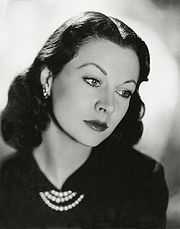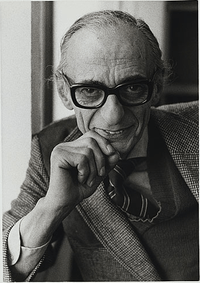Athol Shmith
| Athol Shmith | |
|---|---|
|
Athol Shmith, 1976 photographed by Carol Jerrems (1949–1980) | |
| Born |
Louis Athol Shmith 19 August 1914 Melbourne, Australia |
| Died | 21 October 1990 (aged 76) |
| Nationality | Australian |
| Known for | Photography |
| Spouse(s) |
|
Louis Athol Shmith (19 August 1914 – 21 October 1990) was a celebrated studio portrait and fashion photographer and photography educator in his home city of Melbourne, Australia, and contributed to the promotion of international photography within Australia as much as to the fostering of Australian photography in the world scene.
Early life
Shmith was born in Melbourne in 1914 and came from a comfortable and cultured middle-class family; his father was a respected chemist and a fine pianist. Athol Shmith played the vibraphone and considered music as a possible career. His father gave him a camera as a teenager and what was a hobby became a profession in his late teens when Shmith, who had an interest in theatre and played at charity performances, was asked to take the publicity photographs and stills for a show. He saw there was a career in his former hobby and, supported by his family, established a studio in St Kilda. For the first five years he specialised in theatre work and society and wedding portraits through which he first made his reputation, but his professional break had come in the early 1930s when he gained the contract to take portraits of visiting celebrities for the newly formed Australian Broadcasting Commission.[1]
Collins Street studio

In 1939 he moved to a studio in the Rue de la Paix building at 125 Collins Street,[2] run with the assistance of his brother Clive, and sister, Verna, who was his receptionist and who became an expert negative retoucher. The studio had originally been fitted out for Helena Rubenstein, and retained her elegant powder blue and deep pink fittings.[3] Shmith's work expanded to include a range of commercial advertising and illustration and appeared in local society magazines. He exhibited his works in photographic salons at home and abroad, gaining a Fellowship of the Royal Photographic Society in 1933. At the age of just 19 he was appointed Vice-Regal Photographer in Melbourne.[4] He long held the contract for stage and publicity photography for theatre producer J.C. Williamson.[5]
Influenced in his early career by the soft impressionistic style of turn-of-the-century art photographers, Shmith later embraced the clearer light, bolder compositions and design emphasis of art deco modernism which he admired in the fashion, product and portrait work of (Sir) Cecil Beaton, Edward Steichen and Hollywood portraitist George Hurrell. By the late 1930s, he was seen as representing a new modern style of work. After World War II Shmith embraced the "New Look"[6][7] and the spirit of post-war recovery in fashion illustration, becoming the most respected professional in the field in Australia. The studio was increasingly associated with zestful, creative fashion photography. Shmith, who prided himself on his skill in lighting, had learned much from the model of European modernism and the quirkiness of surrealism. He was also indebted to the top-lit and back-lit glowing ‘Hollywood lighting’ style of portraiture popularised by Californian photographer George Hurrell in the 1920s and 1930s. He described his portrait of actress Vivien Leigh in costume as lit by his 'inky dinky light', a top spotlight diffused by tracing paper. Shmith treated his female sitters and models as princesses.[8] In 1950 John Cato, the son of Jack Cato became co-director of Shmith's studio.[9] From the 1960s Shmith responded to cultural shifts with a freeing-up of the style and setting of his fashion photographs. He moved from the studio into everyday environments, like the street and beach.[10] Shmith acknowledged as his inspiration during this period the work of Richard Avedon.[11]
Athol Shmith was urbane, charming and witty and also madcap.[12] Shmith was less concerned with gravitas and the moral exemplar of ‘greatness’ of his many famous sitters and celebrated models than with conveying their elan, style and creative spirit. He was fascinated with his subjects rather than in awe of them.
Contributions to photography in Australia
Athol Shmith's commercial career produced photographs that embodied a world of grace, glamour and allure. Throughout the 1960s Shmith remained energetic and dynamic in his development of fashion work, but by the close of the decade he took on roles in photographic heritage and education. In 1968 he helped to establish a photography department at the National Gallery of Victoria and in 1971 closed his business to take on a new role as head of the Photography Department at Prahran College of Advanced Education, on the same Prahran campus as is now occupied by Swinburne University of Technology. He taught there[13] with his business partner John Cato[14] and the film-maker Paul Cox. While teaching he produced and exhibited his 1973 psychedelic 'Anamorphic Series' now held in the collection of the National Gallery of Australia. His support assisted the careers of students whom he closely mentored such as Sue Ford, Bill Henson, Carol Jerrems and Christopher Koller. Ill health caused his retirement from the College in 1979, but after recovery he continued with a limited professional practice, including documentation of the 1980 opening of the High Court of Australia building. He was appointed a Member of the Order of Australia the following year.
Shmith's work was collected by the major art museums in the 1970s and 1980s[15] and he had a retrospective in 1977 at the Australian Centre for Photography.[16] In 1989 the National Gallery of Victoria held an Athol Shmith survey. The major holdings of his work can be found in the National Gallery of Victoria[17] and the National Gallery of Australia. A small monograph on his work was published in 1980[18] and a more substantial one[19] was written by curator Isobel Crombie and published in association with his major retrospective at the National Gallery of Victoria in 1989. Posthumously, the NGV showed his work in 1996 in their photography gallery.[20] A National Gallery of Australia Travelling Exhibition at the Monash Gallery of Art, Wheelers Hill, Victoria, 7 February–30 March 2003, and 5 other venues to March 2004, included a catalogue.[21] The Paris End: Photography, Fashion and Glamour at the NGV 3 June – 1 October included Shmith's photographs along with those of Jack Cato, Mina Moore, Ruth Hollick, Wolfgang Sievers, Helmut Newton and Henry Talbot and was accompanied by a substantial publication by NGV Curator of Photography Susan van Wyck [22]
Personal life
From 1948 to 1958, he was married to fashion model 'Bambi'[23] (Patricia Tuckwell, sister of Barry Tuckwell and future wife of Lord Harewood, 1st cousin to Queen Elizabeth II). Their son Michael Shmith, a senior writer with The Age newspaper, now retired, was born in 1949; and his son Sam follows in his grandfather's footsteps as a photographer.
References
- ↑ ^ Shmith, Michael. Australian Dictionary of Biography entry for 'Shmith, Louis Athol (1914–1990)' http://adb.anu.edu.au/biography/shmith-louis-athol-15802 accessed 30 January 2013
- ↑ Shmith, Michael 'Paris, Melbourne', Chapter Two of Van Wyk, Susan; Shmith, Michael, 1949–; Whitfield, Danielle; National Gallery of Victoria (2006), The Paris end : photography, fashion & glamour, National Gallery of Victoria, ISBN 978-0-7241-0271-6
- ↑ Culture Victori website http://www.cv.vic.gov.au/stories/athol-shmith/7571/athol-shmith/ accessed 30 January 2013
- ↑ Cowen, Zelman Sir (1965), Sir John Latham and other papers, Oxford University Press, retrieved 30 January 2013
- ↑ Shmith, Michael Australian Dictionary of Biography entry for 'Shmith, Louis Athol (1914–1990)' http://adb.anu.edu.au/biography/shmith-louis-athol-15802 accessed 30 January 2013
- ↑
- "In 1948, an event occurred which was to have a huge impact on the Australian fashion scene: Myer imported a selection of Christian Dior's breathtaking 'New Look' garments. To introduce these beautiful gowns to an avid Australian audience, a group of French models was brought to Melbourne for the opening parades. Athol Shmith was appointed the official photographer"
- "In 1948, an event occurred which was to have a huge impact on the Australian fashion scene: Myer imported a selection of Christian Dior's breathtaking 'New Look' garments. To introduce these beautiful gowns to an avid Australian audience, a group of French models was brought to Melbourne for the opening parades. Athol Shmith was appointed the official photographer"
- ↑ Maynard, Margaret (1995) ‘The Wishful Feeling About Curves’: Fashion, Femininity, and the ‘New Look’ in Australia. Journal of Design History (1995) 8(1): 43–59 doi:10.1093/jdh/8.1.43
- ↑ "Rosalie Warne asks leading men: 'What most appeals to you in a woman?'.". The Argus (Melbourne: National Library of Australia). 26 November 1953. p. 9. Retrieved 31 January 2013.
- ↑ Newton, Gael (1980), Silver and grey : fifty years of Australian photography, 1900–1950, Angus & Robertson, ISBN 978-0-207-14109-6
- ↑ McNeil, Peter, 1966–; Karaminas, Vicki; Cole, Cathy, 1950– (2009), Fashion in fiction : text and clothing in literature, film and television (English ed ed.), Berg, ISBN 978-1-84788-359-9 page 63
- ↑ Ennis, Helen; Hall, Susan; National Library of Australia (2004), Intersections : photography, history and the National Library of Australia, National Library of Australia, ISBN 978-0-642-10792-3
- ↑ Shmith, Michael (2006)'The last time I saw Paris:the Paris end of Collins Street, to Michael Shmith, meant heady days of photography, glamour and models' The Age 2 June 2006.http://www.theage.com.au/news/arts/the-last-time-i-saw-paris/2006/06/02/1148956490997.html?page=fullpage#contentSwap2
- ↑ Pascoe, Joseph and Victorian College of the Arts. Creating: the Victorian College of the Arts. Palgrave Macmillan Australia, 2000. P.9. ISBN 0-9585743-8-3, ISBN 978-0-9585743-8-9
- ↑ see Cato, John. Athol Shmith (obituary) Art and Australia Vol 29 No 1 Spring 1991 p. 43
- ↑ Warren, Lynne (Author/Editor). Encyclopedia of Twentieth-century Photography. CRC Press, 2006 ISBN 0-415-97665-0. P.87
- ↑ [Athol Shmith : Australian Art and Artists file], retrieved 30 January 2013
- ↑ Shmith, Michael (2014) 'Athol Shmith: My father in the frame'. Melbourne, The Age 1 August 2014 Accessed 01.08.2014
- ↑ Shmith, Athol; Stubbs, Dacre; Cato, John (1980), Athol Shmith, Richmond Hill Press, ISBN 978-0-908157-06-8
- ↑ Isobel Crombie, Athol Shmith (authors). Athol Shmith, photographer. Schwartz Publishing, 1989 ISBN 0-86753-422-2
- ↑ Shmith, Athol; Van Wyk, Susan; National Gallery of Victoria (1996), Athol Shmith : fashion photography from the 1940s to the 1970s, National Gallery of Victoria, retrieved 31 January 2013
- ↑ Karsh, Yousuf; Shmith, Athol, 1914–1990; National Gallery of Australia; Monash Gallery of Art (2000), The good, the great & the gifted : camera portraits by Yousuf Karsh of Ottawa and Athol Shmith of Melbourne, National Gallery of Australia Travelling Exhibitions, retrieved 31 January 2013
- ↑ Van Wyk, Susan; Shmith, Michael, 1949–; Whitfield, Danielle; National Gallery of Victoria (2006), The Paris end : photography, fashion & glamour, National Gallery of Victoria, ISBN 978-0-7241-0271-6
- ↑
- "Bambi Shmith, wife of photographer Athol Shmith of Melbourne, derives her nickname from her big brown eyes. Before her marriage she was a violinist in the Sydney Symphony Orchestra, but now finds time only for music as a hobby. She has done modelling work for seven years".
External links
- Pictures at Culture Victoria
- Melbourne post-war photography State Library of Victoria, Australia
|
